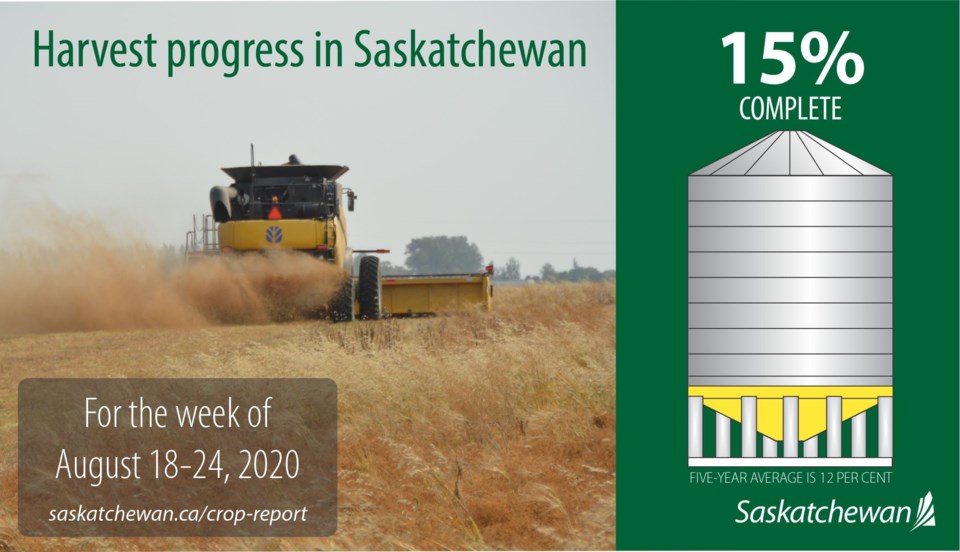Warm, dry conditions continued this week which allowed crop development and maturation to progress and farmers in all regions of the province to make some harvest headway. Fifteen per cent of the crop is combined, up from four per cent last week and ahead of the five-year average of 12 per cent (2015-2019) for this time of year. An additional 16 per cent of the crop is now swathed or ready to straight-cut, slightly behind the five-year average (2015-2019) of 17 per cent.
Eighty-nine per cent of fall rye, 82 per cent of winter wheat, 59 per cent of lentils, 56 per cent of field peas, 20 per cent of barley, 15 per cent of durum, nine per cent of oats, five per cent of spring wheat and two per cent of canola has been combined. An additional 16 per cent of canola has been swathed or is ready to straight-cut.
East-Central Saskatchewan:
·Crop District 5 – Melville, Yorkton, Cupar, Kamsack, Foam Lake, Preeceville and Kelvington areas
·Crop District 6A – Lumsden, Craik, Watrous and Clavet areas
Farmers in the east-central region have made good harvest progress this week with nine per cent of the crop now combined, up from two per cent last week and ahead of the five-year average (2015-2019) of four per cent. An additional 17 per cent of the crop is swathed or ready to straight-cut, with the five-year average (2015-2019) being 16 per cent. There continues to be reports of premature ripening and incomplete filling of seed in crops.
Ninety per cent of winter wheat, 77 per cent of fall rye, 62 per cent of lentils, 55 per cent of field peas, 20 per cent of barley, four per cent of durum, two per cent of spring wheat and one per cent of canola is now in the bin. An additional 15 per cent of canola has been swathed or is ready to straight-cut.
There were scattered rain showers throughout the east-central region, with most areas receiving less than 10 mm of rain. The Esterhazy area received the highest amount of rain in the region this week with 48 mm. The Foam Lake area received 40 mm, the Langenburg area 35 mm, the Pelly and Wadena areas six mm, the Saltcoats, Lipton and Craik areas five mm and the Earl Grey area two mm. The Kuroki area has received the most precipitation in the region since April 1 with 283 mm.
Topsoil moisture conditions were maintained. Cropland topsoil moisture is rated as 38 per cent adequate, 37 per cent short and 25 per cent very short. Hay and pasture land topsoil moisture is rated as 17 per cent adequate, 44 per cent short and 39 per cent very short.
The majority of crop damage this week was due to dry conditions, heat and wind. There were also reports of aphids and bertha armyworms. Pasture conditions in the region are rated as 11 per cent good, 28 per cent fair, 45 per cent poor and 16 per cent very poor.
Farmers are busy hauling bales, desiccating, swathing and combining earlier seeded crops.
Provincially
Harvest progress is most advanced in the southern regions. Farmers in the southwest region have 31 per cent combined, the southeast region 19 per cent, the west-central 12 per cent, the east-central nine per cent, the northeast four per cent and the northwest two per cent.
There were scattered rain showers throughout the province this past week, with most areas receiving trace amounts of rain. Isolated parts of the eastern regions, along with most of Crop District 9B in the northwest region, received more than 25 mm of rain. Areas west of Turtleford received the highest amount of rain this week with 83 mm.
Minimal rainfall and warm temperatures continued to deplete topsoil moisture conditions in most areas of the province. Cropland topsoil moisture is rated as one per cent surplus, 37 per cent adequate, 42 per cent short and 20 per cent very short. Hay and pasture land topsoil moisture is rated as one per cent surplus, 27 per cent adequate, 41 per cent short and 31 per cent very short.
The majority of crop damage this week was due to lack of moisture, heat, wind and insects such as grasshoppers, bertha armyworms and aphids. There continue to be reports of premature ripening and heat stress in both crops and pastures. There were also reports of localized flooding in the northwest region where higher amounts of rainfall was received.
Provincially, pasture conditions are rated as two per cent excellent, 19 per cent good, 41 per cent fair, 28 per cent poor and 10 per cent very poor.
Farmers are busy getting equipment and bins ready for harvest, swathing, desiccating and combining.
With harvest underway in Saskatchewan, we want to remind producers to exercise caution and remain safe.
A complete, printable version of the Crop Report is available online at www.saskatchewan.ca/crop-report.
Follow the 2020 Crop Report on Twitter at @SKAgriculture.

